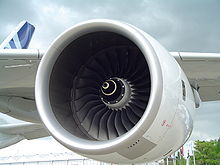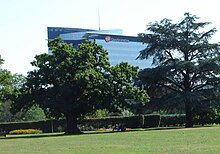Manufacturing in the United Kingdom
The United Kingdom, where theIndustrial Revolutionbegan in the late 18th century, has a long history ofmanufacturing,which contributed to Britain'searly economic growth.During thesecond half of the 20th century,there was a steady decline in the importance of manufacturing and theeconomy of the United Kingdomshifted towardservices.Manufacturing, however, remains important for overseas trade and accounted for 44% of goods exports in 2014.[1]In June 2010, manufacturing in the United Kingdom accounted for 8.2% of the workforce and 12% of the country's national output. TheEast MidlandsandWest Midlands(at 12.6 and 11.8% respectively) were the regions with the highest proportion of employees in manufacturing.Londonhad the lowest at 2.8%.[2][3]
History
[edit]Manufacturing in the United Kingdom expanded on an unprecedented scale in the 19th century.Innovation in Britainled to revolutionary changes in manufacturing, the development offactory systems,and growth of transportation by railway and steam ship that spread around the world.[4]Its growth was driven by international trading relationships Britain developed with Asia, Europe and the Americas, as well as entrepreneurialism, work ethic and the availability of natural resources such as coal. The main sectors were textiles, iron and steel making, engineering, and later ship building. Between 1809 and 1839, exports tripled from £25 million to £76 million, while imports nearly doubled from £28 million to £52 million during the same period; by 1849, exports were £124 million and imports were £79 million.[5]In many industrial sectors, Britain was the largest manufacturer in the world and the most technologically advanced.[4][6][7]
In the later part of the 19th century, a second phase developed which is sometimes known as theSecond Industrial Revolution.Germany and later the United States, which made use of theAmerican system of manufacturing,caught up and overtook Britain as the world's largest manufacturers in the early 20th century. Nonetheless, Britain remained one of the largest industrial producers. By the middle of the century, in 1948, manufacturing (including utilities and oil and gas extraction) made up 48% of the UK economy. In the post-war decades, manufacturing began to lose its competitive advantage andheavy industryexperienced a relative decline. By 2013, the percentage of manufacturing in the economy (including utilities and oil and gas extraction) had fallen to 13%, replaced by services which had risen from 46% to 79% over the same period.[8]
The trend ofdeindustrialisation in the United Kingdomis common to all matureWesterneconomies.[9]Heavy industry, employing many thousands of people and producing large volumes of low-value goods (such assteelmaking) has either become highly efficient (producing the same amount of output from fewer manufacturing sites employing fewer people; for example, productivity in the UK's steel industry increased by a factor of 8 between 1978 and 2006[10]) or has been replaced by smaller industrial units producing high-value goods (such as theaerospaceandelectronicsindustries).[11]
How the manufacturing sector is accounted for has however changed as part of manufacturing companies providing services and for those supplying it, so the actual size of the sector will vary in size according to the criteria in question.[12]
Recent trends
[edit]
Although the manufacturing sector's share of both employment and the UK's GDP has steadily fallen since the 1960s, data from theOECDshows that manufacturing output has steadily increased in terms of both production and value since 1945. A 2009 report fromPricewaterhouseCoopers,citing data from the UKOffice for National Statistics,stated that manufacturing output (gross value addedat 2007 prices) has increased in 35 of the 50 years between 1958 and 2007, and output in 2007 was at record levels, approximately double that in 1958.[13]
Manufacturing employment has fallen faster in the UK since 1998. This started with manufacturing productivity flatlining from 1993 to 1997 and a rise inpound sterling.PricewaterhouseCoopers presumed that British manufacturing was less able to adapt to new production immune from Asian competition. Since 1993, the UK has also invested less in R&D and adaptation than its OECD competitors.[citation needed]However, manufacturing remains an important sector of the modern British economy and the UK is one of the most attractive countries in the world for direct foreign industrial investment in 2003.[14]
Yet, as of 2019[update],the manufacturing sector was worth £393 billion or $514 billion in the United Kingdom, according to office of national statistics.[full citation needed]
Manufacturing has recently been rising in the UK with increased domestic demand with a fall in the pound too. The UK leaving the EU could lead to increased opportunity for access to cheaper raw materials from Africa and South America.[citation needed]More firms returning their production to the UK have also bucked the trend, which might continue as many companies reassess their investments in China, a process sometimes known as on-shoring.
Engineering
[edit]
Engineering and allied industries comprise the single largest sector, contributing 30.8% of total Gross Value Added in manufacturing in 2003.[very out of date]Within this sector,transport equipmentwas the largest contributor, with 7 global car manufacturers being present in the UK. These include British makers now owned by overseas companies suchMINI(BMW),Rolls-Royce(BMW),Jaguar Land Rover(Tata),Bentley(Volkswagen) andVauxhall Motors(Stellantis) and plants making vehicles under foreign ownership and branding such asNissan(Sunderland) andToyota(Burnaston) with a number of smaller, specialist manufacturers includingAston Martin,LotusandMorgan,and commercial vehicle manufacturers includingLeyland Trucks(a subsidiary ofPACCAR),TEVVA,Alexander Dennis,JCB,Caterpillar,London Electric Vehicle CompanyandCase-New Hollandalso being present. The British motor industry also comprises numerous components for the sector, such asFord'sdiesel engineplant inDagenham,which produces half of Ford's diesel engines globally.

Triumph Motorcycles Ltdis the only wholly British owned major transport manufacturer.
A range of international companies likeAlstom,Hitachi,CAFandSiemensmanufacture railway locomotives and other related components. Associated with this sector are the defence and aerospace industries. As of 2022, the UK aerospace industry was the second largest in the world behind that of the United States,[15]with a turnover of over $34.5 billion. Major players in the UK defence and aerospace market includeBAE Systems,Airbus,GKN Aerospace,Leonardo,Babcock International,Rolls-Royce,Safran,General Electric,MBDAandThales.BAE SystemsandBabcock Internationalare also major builders of warships, operations which constitute a significant part of the UK's remaining marine industrial base. The commercial maritime sector, meanwhile, still includes historic names such asHarland and Wolff,Cammell Laird,andA&P Group,whilst companies such asPrincess,Fairline BoatsandSunseekerare large scale manufacturers of private motor yachts.
Another important component of engineering and allied industries is electronics, audio and optical equipment, with the UK having a broad base of domestic firms, alongside a number of foreign firms manufacturing a wide range of TV, radio and communications products, scientific and optical instruments, electrical machinery and office machinery and computers.
Chemicals and chemical-based products are another important contributor to the UK's manufacturing base. Within this sector, the pharmaceutical industry is particularly successful, with the world's second and seventh largest pharmaceutical firms (GlaxoSmithKlineandAstraZenecarespectively) being based in the UK and having major research and development and manufacturing facilities there.

Other sectors
[edit]Other important sectors of the manufacturing industry include food, drink, tobacco, paper, printing, publishing and textiles. Examples of major companies in these industries areDiageo,Unilever,Cadbury,Tate & Lyle,British American Tobacco,Imperial Tobacco,HarperCollins,andReed Elsevier.
See also
[edit]- Economic history of the United Kingdom
- Nationalization (UK)
- Science and technology in the United Kingdom
- Manufacturing in Wales
References
[edit]- ^"Briefing Paper: Manufacturing statistics and policy".House of Commons Library:12. 6 August 2015.Retrieved6 June2016.
- ^"UK manufacturers provide a strong foundation for growth in the UK"EEF(2017)
- ^Hennik Research.Annual Manufacturing Report: 2017(Dec. 2016)
- ^abWalker, William (1993)."National Innovation Systems: Britain".In Nelson, Richard R. (ed.).National innovation systems: a comparative analysis.New York: Oxford University Press.ISBN0195076176.
- ^"Steam & Speed: Industry, Power & Social Change in 19th-Century Britain".Victoria and Albert Museum.Retrieved14 June2015.
- ^Porter, Andrew (1998).The Nineteenth Century, The Oxford History of the British Empire Volume III.Oxford University Press. p. 8.ISBN0-19-924678-5.Retrieved22 July2009.
- ^Marshall, PJ (1996).The Cambridge Illustrated History of the British Empire.Cambridge University Press. pp. 156–57.ISBN0-521-00254-0.Retrieved22 July2009.
- ^"Seven things you need to know about the UK economy".The Guardian.24 April 2014.Retrieved14 June2015.
- ^"Bank of England's Broadbent struck by lack of UK credit growth".Reuters.24 November 2015.Retrieved25 November2015.
- ^http:// uksteel.org.uk/fact1.htm
- ^"Pioneering Great British Products".EEF The Manufacturers' Organisation.Retrieved28 September2014.
- ^the manufacture
- ^The future of UK manufacturing: Reports of its death are greatly exaggeratedArchived2011-07-19 at theWayback Machine
- ^Manufacturing In Britain: A Survey Of Factors Affecting Growth & Performance,ISR/Google Books, revised 3rd edition. 2003, page 1.ISBN978-0-906321-30-0
- ^"United Kingdom - Aerospace and Defense".trade.gov.3 November 2023.Retrieved2023-11-10.
External links
[edit]- "UK manufacturers provide a strong foundation for growth in the UK"EEF(2017)
- Hennik Research.Annual Manufacturing Report: 2017(Dec. 2016)
- [1]:Annual event, National Manufacturing Debate, held at Cranfield University. 2013 topic "National Strategy for UK Manufacturing"
- [2]Certified Made in the UK design and manufacturing organisation.
